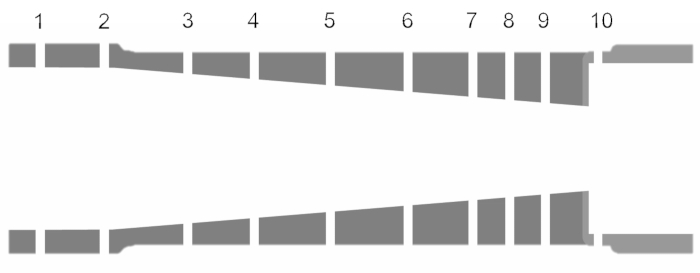Variations du nombre de Mach et de la pression le long d'une tuyère convergente et d'une tuyère de Laval
Vue d'ensemble
Source: Shreyas Narsipur, Génie mécanique et aérospatial, North Carolina State University, Raleigh, Caroline du Nord
Une buse est un dispositif qui est couramment utilisé pour accélérer ou décélérer le débit en raison de sa section transversale variable. Les buses sont largement utilisées dans les systèmes de propulsion aérospatiale. Dans les fusées, le propulseur qui est éjecté de la chambre est accéléré par une buse pour créer une force de réaction qui propulse le système. Dans les moteurs à réaction, une buse est utilisée pour transformer l'énergie d'une source à haute pression en énergie cinétique de l'échappement pour produire la poussée. Le modèle isentropique le long de la buse est suffisant pour une analyse de premier ordre car le flux dans une buse est très rapide (et donc adiabatique à une première approximation) avec très peu de pertes de friction (parce que le flux est presque unidimensionnel avec une pression favorable d'onde de choc et les buses sont relativement courtes).
Dans cette expérience, deux types de buses sont montés sur une plate-forme d'essai de buse, et un flux de pression est créé à l'aide d'une source d'air comprimé. Les buses sont exécutés pour différents paramètres de back-pressure pour analyser le flux interne dans les buses dans des conditions de débit variables, identifier les différents régimes de débit, et comparer les données aux prédictions théoriques.
Procédure
Dans cette démonstration, une plate-forme d'essai de buse a été utilisée, qui consistait en une source d'air comprimé qui canalise l'air à haute pression à travers les buses testées, comme le montre la figure 5. La pression d'écoulement varie de 0 à 120 psi et est contrôlée à l'aide d'une valve mécanique. Alors que les pressions sont mesurées à l'aide d'un capteur externe, les débits de masse dans la buse sont mesurés par une paire de rotamètres placés juste avant l'échappement de la plate-f
Résultats
Les constantes suivantes ont été utilisées dans l'analyse : chaleur spécifique de l'air sec, : 1,4 ; zone de buse de référence, Ai 0,0491 en2, et pression atmosphérique standard, Patm 14,1 psi. Les figures 8 et 9 montrent la variation du rapport de pression et du nombre de Mach sur toute la longueur de la buse (normalisée en fonction de la longueur totale de la buse) pour divers réglages de pression arrière pour les buses convergentes et convergentes...
Applications et Résumé
Les buses sont couramment utilisées dans les systèmes de propulsion d'aéronefs et de fusées, car elles offrent une méthode simple et efficace pour accélérer le débit sur des distances restreintes. Afin de concevoir des buses en fonction d'une application donnée, une compréhension du comportement de flux et des facteurs qui affectent ledit comportement pour une gamme de conditions de débit est essentielle pour concevoir des systèmes de propulsion efficaces. Dans cette démonstration, les buses convergentes et ...
Tags
Passer à...
Vidéos de cette collection:

Now Playing
Variations du nombre de Mach et de la pression le long d'une tuyère convergente et d'une tuyère de Laval
Aeronautical Engineering
38.0K Vues

Performances aérodynamiques d'un modèle réduit d'avion : Le DC-6B
Aeronautical Engineering
8.3K Vues

Caractérisation de l'hélice : Variations du pas, du diamètre et du nombre de lame sur la performance
Aeronautical Engineering
26.5K Vues

Comportement de l'aile : Distribution de la pression sur une aile de Clark Y-14
Aeronautical Engineering
21.2K Vues

Performance des ailes du Clark Y-14 : Déploiement des dispositifs hypersustentateurs (volets et lamelles)
Aeronautical Engineering
13.4K Vues

Méthode des sphères de turbulence : Évaluation de la qualité de l'écoulement en soufflerie
Aeronautical Engineering
8.7K Vues

Flux cylindrique croisé : Mesurer la distribution de la pression et estimer les coefficients de traînée
Aeronautical Engineering
16.2K Vues

Imagerie Schlieren: Une technique pour visualiser les caractéristiques des écoulements supersoniques
Aeronautical Engineering
11.7K Vues

Visualisation de l'écoulement dans un tunnel hydrodynamique : Observation d'un tourbillon sur une aile Delta
Aeronautical Engineering
8.2K Vues

Visualisation de l'écoulement de colorants en surface : Une méthode qualitative pour visualiser les lignes de courant dans un écoulement supersonique
Aeronautical Engineering
4.9K Vues

Tube de Pitot : Un dispositif pour mesurer la vitesse du flux d'air
Aeronautical Engineering
49.2K Vues

Anémomètre à température constante : Un outil pour étudier les écoulements dans la couche limite turbulente
Aeronautical Engineering
7.3K Vues

Transducteur de pression : Calibrage à l'aide d'un tube de Pitot
Aeronautical Engineering
8.5K Vues

Contrôle de vol en temps réel : Étalonnage de capteurs embarqués et acquisition de données
Aeronautical Engineering
10.3K Vues

Aérodynamique des multicoptères : Caractérisation de la poussée sur un hexacoptère
Aeronautical Engineering
9.2K Vues


